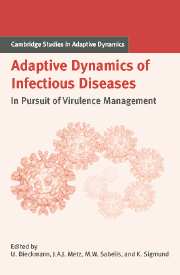Book contents
- Frontmatter
- Contents
- Contributing Authors
- List of Boxes
- Notational Standards
- 1 Introduction
- A Setting the Stage
- B Host Population Structure
- C Within-Host Interactions
- D Pathogen–Host Coevolution
- E Multilevel Selection
- F Vaccines and Drugs
- Introduction to Part F
- 23 Managing Antibiotic Resistance: What Models Tell Us?
- 24 Evolution of Vaccine-resistant Strains of Infectious Agents
- 25 Pathogen Evolution: The Case of Malaria
- 26 Vaccination and Serotype Replacement
- G Perspectives for Virulence Management
- References
- Index
- International Institute for Applied Systems Analysis
24 - Evolution of Vaccine-resistant Strains of Infectious Agents
Published online by Cambridge University Press: 15 January 2010
- Frontmatter
- Contents
- Contributing Authors
- List of Boxes
- Notational Standards
- 1 Introduction
- A Setting the Stage
- B Host Population Structure
- C Within-Host Interactions
- D Pathogen–Host Coevolution
- E Multilevel Selection
- F Vaccines and Drugs
- Introduction to Part F
- 23 Managing Antibiotic Resistance: What Models Tell Us?
- 24 Evolution of Vaccine-resistant Strains of Infectious Agents
- 25 Pathogen Evolution: The Case of Malaria
- 26 Vaccination and Serotype Replacement
- G Perspectives for Virulence Management
- References
- Index
- International Institute for Applied Systems Analysis
Summary
Introduction
Vaccination is one of the most notable successes of modern medicine. Smallpox has been eradicated, and many serious infectious diseases of childhood have been brought under control, with a vast reduction in the associated morbidity and mortality. To achieve this required placing a huge selection pressure upon the associated pathogens. Despite this pressure, there has been little evolution of the pathogen strains that escape from vaccine-induced immunity.
In this chapter, I first present a modeling approach that allows consideration of competition between strains of pathogens and their responses to changes in the balance of competition that are imposed by a vaccination campaign. This framework allows the calculation of conditions that would allow the emergence of a vaccineresistant strain. The numerical simulation of the evolution of vaccine resistance gives interesting insights into the time scale over which it might occur. Finally, I discuss four case studies from infectious diseases of humans.
Theoretical Framework
This section describes the basic theoretical framework on which the discussion in this chapter is built.
Basic reproduction ratio
The community-level impact of vaccines is best considered within the context of the basic reproduction ratio R0, which is defined as the number of secondary cases caused by one infectious individual introduced into a community in which everyone is susceptible. R0 can be generalized to Rp, the number of secondary cases caused by one infectious individual introduced into a community where a fraction p have been vaccinated and everyone else is susceptible.
- Type
- Chapter
- Information
- Adaptive Dynamics of Infectious DiseasesIn Pursuit of Virulence Management, pp. 339 - 346Publisher: Cambridge University PressPrint publication year: 2002
- 3
- Cited by



